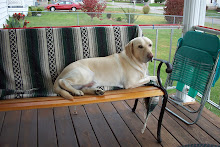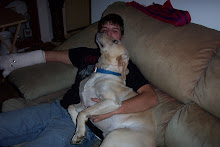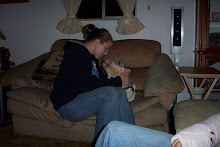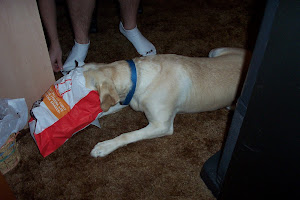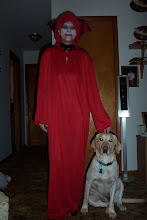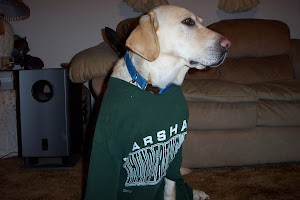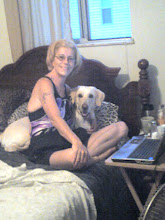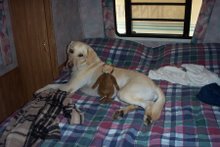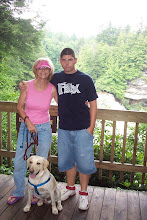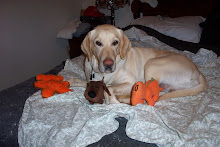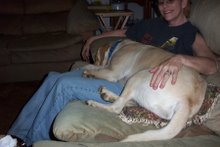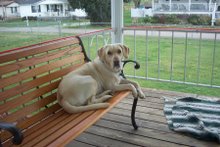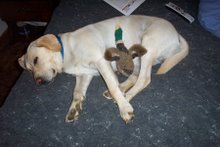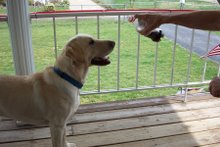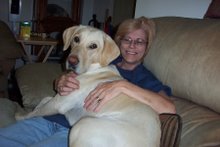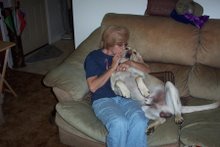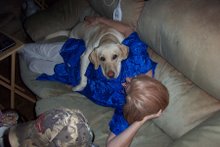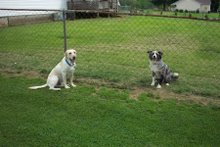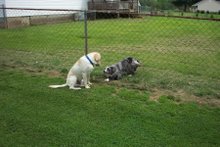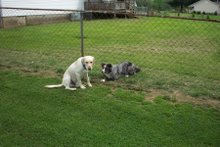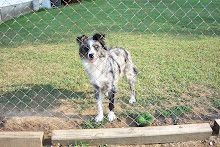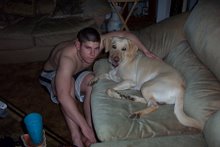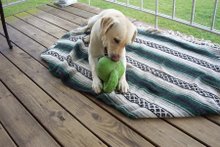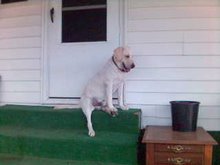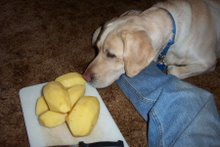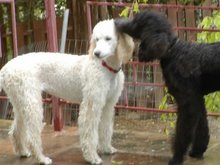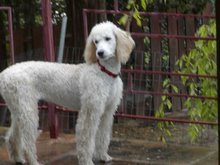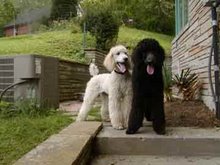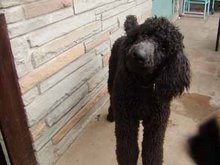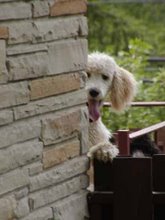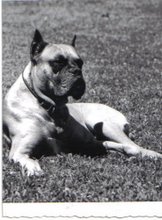On May 15th of 2005, my soul-mate, Kallee, passed away in her sleep. She and I had been together for 13 yrs. She died on a Sunday. The man I had been with for close to 15 yrs. was kind enough to let me bury her on his farm. My husband now, went with me to dig her grave and bury her. As I sat with her body, wrapped in her favorite blanket, I looked around. She was being buried along with many other animals that had belonged to his family.
Like me, his family, and him, loved animals and wanted to bury them with dignity and in a familiar surrounding. When I became a member of his family, we purchased a beautiful Rottweiler named Cratty's Von Maxwell, or Max for short. Max was not my first dog, however. My parents loved Dalmations and I grew up with 3 of them.
The female, my father named Taryton, after the cigarette, because she had a black patch over one eye, died in 1982. Kenny,(my ex), buried her in the backyard of his mother's house. In 1983, we purchased Max. Helen, (my mother-in law), deeded the property where she grew up, on Homestead Rd., across from the Jenkins Plantation, in the Powell Wetlands on Rt. 2, Lesage, WV, to Kenny.
Max was diagnosed with bladder cancer and had to be euthenized in 1992. He became the first member of the cemetery. In this private cemetery, there is a Llama, 2 pygmy goats, a miniature horse, another Rottie, named Ralph, and a mix called Mikey. Kallee was the last to be buried there. Burying an animal on your property, as far as I am concerned, is the ultimate last show of love.
Pet cemeteries that offer burial or cremation services are a fabulous idea. This gives people that don't have the property to bury their beloved pet on, a means of showing that last bit of love and respect to their pets. I know many people feel that animals don't need a funeral. To those people I say, "you obviously have never owned a pet. Because if you had, you would not feel that way."
Kallee and Tamara
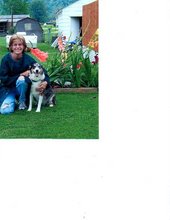
A Beautiful Summer Day.
Madam Kallee, CTD, CGC - 1994-2005 - Certified Therapy Dog and a Canine Good Citizen
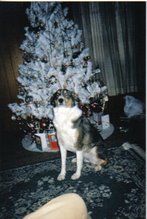
I am so pretty!
Kallee, T.D.I., CGC - Certified Therapy Dog and a Canine Good Citizen - 1994-2005

I loved to pose for the camera.
Hat Girl.
The things I do for my mom!
Happiness.
Bubby knows how to scratch a tummy.
Best of Friends.
Mine! No, Mine!, No Mine!!!
Whew !
Bubby wears me out!
This is the Life.
Just relaxing with bubby.
Kallee and Mr. Monkey
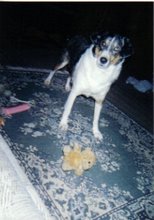
See Mr. Monkey? Wanna play?
Miss Cool.

I loved to wear my shades.
Saturday, December 29, 2007
Friday, December 21, 2007
Slain Marine's Dog Adopted By His Family.
ALBANY, Ga. (AP) — A military working dog wounded in Iraq during a rocket attack that killed its Marine handler was adopted Friday by the slain Marine’s family. The adoption of Lex, an 8-year-old German Shepherd, by the family of fallen Marine Cpl. Dustin Lee marked the first time the U.S. military has granted early retirement to a working dog so it could live with a former handler’s family, officials said.
“Nobody can do anything to replace the void in this family,” said Col. Christian Haliday, commander of the Marine Corps Logistics Base in Albany, where Lee and Lex were assigned. “We hope Lex can bring a small piece of his spirit and help maintain his memory.” On hand for the ceremony at the base were the Marine’s parents, Jerome and Rachael Lee, his sister, Mattie, 16, and brother, Cameron, 12, of Quitman, Miss.
“It’s not going to bring back my brother, but it’s something close to it,” said Mattie Lee as she played with Lex after the ceremony. Lee’s family planned to take the bomb-sniffing dog home on Saturday. Military officials initially told the family that Lex had another two years of service before he could be adopted.
But the family lobbied for months — even enlisting the aid of a North Carolina congressman — and the adoption came exactly nine months after the 20-year-old Marine was killed and his dog wounded on March 21 in Iraq’s Anbar Province. 2nd Lt. Caleb Eames, spokesman for the Albany base, said Lee and Lex were sitting outside at a forward operating base in Karmah when they were hit by shrapnel from a 73mm rocket explosion.
“A part of Dustin is in Lex,” said the fallen Marine’s father. “To have Lex at home is a part of having Dustin at home.” Rachael Lee said she believes her son’s spirit will live on through the dog because of their close bond and because they were together during the final moments of her son’s life. “It was blood on blood,” she said. “We can’t get Dustin back, but we have Lex.”
While Marines tried to treat Lee’s wounds, another dog handler was sent to take Lex for treatment, said Staff Sgt. Dana Brown, the regional kennel master for the pair in Iraq. “Lex, from my understanding, was kind of laying on him or near him, protecting him,” Brown said in an interview from the Quantico Marine Base in Virginia. “He just didn’t want to leave him. He knew he belonged there and something was wrong.
Even though he was hurting, he knew he was supposed to stay by his handler.” Brown flew back with Lex to Camp Lejeune, N.C., where the dog’s wounds were treated and she accompanied Lex to Lee’s funeral in April. After 12 weeks of treatment for shrapnel wounds in the shoulder and back, Lex was declared fit for duty and returned to his permanent home at the Albany base.
Brown said Lee and Lex stood out among more than 40 bomb-sniffing dog teams under her supervision, and they performed so well she chose them and one other team to be embedded full-time with specialized units — a Marine reconnaissance unit in Lee’s case. It was Lex’s second tour in Iraq, the first with another handler. “He was cocky,” Brown said of Lee. “He knew he was good and he and his dog were unstoppable.”
Lee joined the Marines after graduating from high school in 2004. His father said his desire to become a dog handler came from the Marine’s mother, who worked with search-and-rescue dogs when Lee was a boy. After completing military police and dog handler training, Lee was assigned to the Albany base in southwestern Georgia. He adopted his first partner, Doenja, and sent him home to Mississippi last year when that 11-year-old dog began losing his sight and had to retire. “Lex is in wonderful shape,” said Eames. “He’s fully operational. His most important mission now is making this wonderful family very happy.”
“Nobody can do anything to replace the void in this family,” said Col. Christian Haliday, commander of the Marine Corps Logistics Base in Albany, where Lee and Lex were assigned. “We hope Lex can bring a small piece of his spirit and help maintain his memory.” On hand for the ceremony at the base were the Marine’s parents, Jerome and Rachael Lee, his sister, Mattie, 16, and brother, Cameron, 12, of Quitman, Miss.
“It’s not going to bring back my brother, but it’s something close to it,” said Mattie Lee as she played with Lex after the ceremony. Lee’s family planned to take the bomb-sniffing dog home on Saturday. Military officials initially told the family that Lex had another two years of service before he could be adopted.
But the family lobbied for months — even enlisting the aid of a North Carolina congressman — and the adoption came exactly nine months after the 20-year-old Marine was killed and his dog wounded on March 21 in Iraq’s Anbar Province. 2nd Lt. Caleb Eames, spokesman for the Albany base, said Lee and Lex were sitting outside at a forward operating base in Karmah when they were hit by shrapnel from a 73mm rocket explosion.
“A part of Dustin is in Lex,” said the fallen Marine’s father. “To have Lex at home is a part of having Dustin at home.” Rachael Lee said she believes her son’s spirit will live on through the dog because of their close bond and because they were together during the final moments of her son’s life. “It was blood on blood,” she said. “We can’t get Dustin back, but we have Lex.”
While Marines tried to treat Lee’s wounds, another dog handler was sent to take Lex for treatment, said Staff Sgt. Dana Brown, the regional kennel master for the pair in Iraq. “Lex, from my understanding, was kind of laying on him or near him, protecting him,” Brown said in an interview from the Quantico Marine Base in Virginia. “He just didn’t want to leave him. He knew he belonged there and something was wrong.
Even though he was hurting, he knew he was supposed to stay by his handler.” Brown flew back with Lex to Camp Lejeune, N.C., where the dog’s wounds were treated and she accompanied Lex to Lee’s funeral in April. After 12 weeks of treatment for shrapnel wounds in the shoulder and back, Lex was declared fit for duty and returned to his permanent home at the Albany base.
Brown said Lee and Lex stood out among more than 40 bomb-sniffing dog teams under her supervision, and they performed so well she chose them and one other team to be embedded full-time with specialized units — a Marine reconnaissance unit in Lee’s case. It was Lex’s second tour in Iraq, the first with another handler. “He was cocky,” Brown said of Lee. “He knew he was good and he and his dog were unstoppable.”
Lee joined the Marines after graduating from high school in 2004. His father said his desire to become a dog handler came from the Marine’s mother, who worked with search-and-rescue dogs when Lee was a boy. After completing military police and dog handler training, Lee was assigned to the Albany base in southwestern Georgia. He adopted his first partner, Doenja, and sent him home to Mississippi last year when that 11-year-old dog began losing his sight and had to retire. “Lex is in wonderful shape,” said Eames. “He’s fully operational. His most important mission now is making this wonderful family very happy.”
Rosie And Alex: A True Love Story.
MELBOURNE, Ark. — This Christmas, 5-year-old Alex Bennett has a new best friend. She plays with him, sleeps with him, calms him down when he becomes frustrated, protects him from danger and will soon be going to school with him, too. Rosie, the newest member of the Bennett household, is part lab, part retriever and, according to Alex’s mother Mandi Bennett, “all heart.”
Rosie is a service dog, specifically trained to work with autistic children. And she takes her job seriously. “Rosie is not quite a year old yet but she’s had extensive training,” Bennett said. “She went through her obedience training at a women’s prison and then she was trained to work with autistic children at an organization called 4 Paws for Ability.” The Ohio-based group trains service dogs to help children with disabilities and their families. Alex was diagnosed with autism in July 2006 and it was Mandi’s mother, Donna Adams, who first found out about service dogs.
“I was doing some research on autism on the Internet and I came across this Web site,” Adams explained. “4 Paws for Ability deals only with service dogs, not seeing-eye dogs. They train dogs in autism assistance, mobility assistance and seizure assistance as well as hearing and multipurpose assistance. “These dogs are just incredible,” she continued. “Some of them are trained to open the fridge, get clothes out of the dryer or even pick up the phone.” Others, like Rosie, are trained to help with the day-to-day problems that a child like Alex faces.
“I knew this would be an answer to our prayers,” Bennett said. “But there was no way I could afford a dog like that.” The price for a service dog can run anywhere from $10,000 to $15,000. “That’s when the community stepped in,” Adams said. “I can’t tell you just how grateful we are to everyone who helped make this possible for Alex. “People have been wonderful,” she continued. “They set up donation accounts at the bank and held benefit gospel concerts at the church. “Then we started getting letters and cards in the mail with money in them,” Bennett said.
“People would send $5, or $10, just because they’d heard about Alex and wanted to help. “I can’t put into words how that made us feel,” she added. The Mill Creek Coffee House in Melbourne even put some of Bennett’s handmade jewelry on display for sale. “We raised almost $500 that way,” she said. “This whole town has been great.” In November, the family was finally able to travel to Xenia, Ohio, to pick up Rosie. They participated in training and tracking exercises every day for two weeks.
“The biggest worry for me is the safety issue,” Bennett said. “Alex loves to run and play but he has no concept of the road or the cars speeding by. “I’ve always been afraid he is going to get outside and end up hurt or lost,” she added with a sigh. But now, thanks to Rosie, some of that worry has been lifted. “During the tracking exercises in Ohio she (Rosie) found him 100 percent of the time,” Bennett said proudly. “She found him in the woods, in the snow and even in a crowded mall.
“When Rosie wears the special harness and Alex is tethered to her, he actually has more freedom,” she continued. “I don’t have to keep a death grip on him when we go out, or go shopping. If there’s a dangerous situation she will lay down and not move. “If she’s not moving, he’s not moving,” she added. “You have no idea what a relief that is for me.” The exact cause for autism remains a mystery, although symptoms can easily be detected during childhood. The word autism comes from the Greek word meaning “self.”
It’s a fitting name for a disease that causes problems in areas of development such as verbal communication and social interactions. Those with the ailment will not socialize with others, tend to avoid eye contact and seem to retreat into their own private world. In some situations, autistic children like Alex will develop repetitive routines or even exhibit uncontrolled behavior in the form of yelling or crying. That is another area that Rosie helps out in. She has been trained to provide behavior disruption and pressure therapy.
“Because Alex doesn’t speak he tends to get easily frustrated,” Bennett said. “So when he starts to get really agitated, Rosie will go nuzzle him or she will lay her head and paw in his lap to calm him down. “It provides a distraction and stops the behavior,” she said. Bennett and Adams agree the best part of the whole experience for them has been watching Alex and Rosie bond. “He just loves her — there’s no other way to say it,” Bennett said. “It’s something to see him come out of that shell and to smile. ... He even started saying ’Mama’ again,” she added softly. Alex attends preschool at the Child and Youth Pediatric Day Clinic in Batesville, and pretty soon Rosie will be enrolling, too.
“We just want to give her a little time to adjust to her new home first,” Bennett said. “He’ll graduate in May and then he’ll be ready to go to kindergarten at a public school” she continued. “That is what really terrifies me and I know it will be scary for him, too. “But this gives me some measure of peace about the situation,” she added, rubbing Rosie’s ears. “Nothing is as scary when you have your best friend with you.”
Rosie is a service dog, specifically trained to work with autistic children. And she takes her job seriously. “Rosie is not quite a year old yet but she’s had extensive training,” Bennett said. “She went through her obedience training at a women’s prison and then she was trained to work with autistic children at an organization called 4 Paws for Ability.” The Ohio-based group trains service dogs to help children with disabilities and their families. Alex was diagnosed with autism in July 2006 and it was Mandi’s mother, Donna Adams, who first found out about service dogs.
“I was doing some research on autism on the Internet and I came across this Web site,” Adams explained. “4 Paws for Ability deals only with service dogs, not seeing-eye dogs. They train dogs in autism assistance, mobility assistance and seizure assistance as well as hearing and multipurpose assistance. “These dogs are just incredible,” she continued. “Some of them are trained to open the fridge, get clothes out of the dryer or even pick up the phone.” Others, like Rosie, are trained to help with the day-to-day problems that a child like Alex faces.
“I knew this would be an answer to our prayers,” Bennett said. “But there was no way I could afford a dog like that.” The price for a service dog can run anywhere from $10,000 to $15,000. “That’s when the community stepped in,” Adams said. “I can’t tell you just how grateful we are to everyone who helped make this possible for Alex. “People have been wonderful,” she continued. “They set up donation accounts at the bank and held benefit gospel concerts at the church. “Then we started getting letters and cards in the mail with money in them,” Bennett said.
“People would send $5, or $10, just because they’d heard about Alex and wanted to help. “I can’t put into words how that made us feel,” she added. The Mill Creek Coffee House in Melbourne even put some of Bennett’s handmade jewelry on display for sale. “We raised almost $500 that way,” she said. “This whole town has been great.” In November, the family was finally able to travel to Xenia, Ohio, to pick up Rosie. They participated in training and tracking exercises every day for two weeks.
“The biggest worry for me is the safety issue,” Bennett said. “Alex loves to run and play but he has no concept of the road or the cars speeding by. “I’ve always been afraid he is going to get outside and end up hurt or lost,” she added with a sigh. But now, thanks to Rosie, some of that worry has been lifted. “During the tracking exercises in Ohio she (Rosie) found him 100 percent of the time,” Bennett said proudly. “She found him in the woods, in the snow and even in a crowded mall.
“When Rosie wears the special harness and Alex is tethered to her, he actually has more freedom,” she continued. “I don’t have to keep a death grip on him when we go out, or go shopping. If there’s a dangerous situation she will lay down and not move. “If she’s not moving, he’s not moving,” she added. “You have no idea what a relief that is for me.” The exact cause for autism remains a mystery, although symptoms can easily be detected during childhood. The word autism comes from the Greek word meaning “self.”
It’s a fitting name for a disease that causes problems in areas of development such as verbal communication and social interactions. Those with the ailment will not socialize with others, tend to avoid eye contact and seem to retreat into their own private world. In some situations, autistic children like Alex will develop repetitive routines or even exhibit uncontrolled behavior in the form of yelling or crying. That is another area that Rosie helps out in. She has been trained to provide behavior disruption and pressure therapy.
“Because Alex doesn’t speak he tends to get easily frustrated,” Bennett said. “So when he starts to get really agitated, Rosie will go nuzzle him or she will lay her head and paw in his lap to calm him down. “It provides a distraction and stops the behavior,” she said. Bennett and Adams agree the best part of the whole experience for them has been watching Alex and Rosie bond. “He just loves her — there’s no other way to say it,” Bennett said. “It’s something to see him come out of that shell and to smile. ... He even started saying ’Mama’ again,” she added softly. Alex attends preschool at the Child and Youth Pediatric Day Clinic in Batesville, and pretty soon Rosie will be enrolling, too.
“We just want to give her a little time to adjust to her new home first,” Bennett said. “He’ll graduate in May and then he’ll be ready to go to kindergarten at a public school” she continued. “That is what really terrifies me and I know it will be scary for him, too. “But this gives me some measure of peace about the situation,” she added, rubbing Rosie’s ears. “Nothing is as scary when you have your best friend with you.”
Thursday, December 20, 2007
QUESTION: How Much Cold Weather Is Too Much For A Dog?
The answer is different for each dog but in general cold weather should bring about extra caution in all dog owners. Here are some general guidelines to consider if you live in snowy & icy climates:
Jagged ice, frozen plant stems, and sidewalk salt are sharp and can cut your dog's footpads. Snow can also collect on the hair between the pads, sometimes forming icy balls that cause pain and injury. Trimming the long hair from the bottoms of the feet may help prevent this. Always check your dog's feet after he's been out in snow. Thoroughly wipe off your dog's legs and stomach when he comes in from out of the sleet, snow or ice.
He can ingest salt, antifreeze or other potentially dangerous chemicals while licking his paws. Avoid letting your dog off the leash on snow or ice, especially during a snowstorm, dogs can lose their scent and easily become lost. More dogs are lost during the winter than during any other season, so make sure yours always wears ID tags. Even in more moderate climate zones, keep the following in mind: Be particularly gentle with elderly and arthritic pets as cold weather can leave their joints extremely stiff and tender.
Stay directly below these pets when they are climbing stairs or jumping onto furniture and consider modifying their environment to make it easier for them to get around. Never leave your dog alone in a car during the winter. It can act as a refrigerator, holding in the cold and causing the animal to freeze to death. Keep in mind that a regular outside dog in cold weather will need a quarter to a third more food than he needs in warm weather in order to generate enough body heat.
Adjust their meals accordingly. Go ahead and put that sweater on Princess, if she'll put up with it. It will help a little, but where pets lose most of their body heat is from the pads of their feet, their ears, and their respiratory tract.
Jagged ice, frozen plant stems, and sidewalk salt are sharp and can cut your dog's footpads. Snow can also collect on the hair between the pads, sometimes forming icy balls that cause pain and injury. Trimming the long hair from the bottoms of the feet may help prevent this. Always check your dog's feet after he's been out in snow. Thoroughly wipe off your dog's legs and stomach when he comes in from out of the sleet, snow or ice.
He can ingest salt, antifreeze or other potentially dangerous chemicals while licking his paws. Avoid letting your dog off the leash on snow or ice, especially during a snowstorm, dogs can lose their scent and easily become lost. More dogs are lost during the winter than during any other season, so make sure yours always wears ID tags. Even in more moderate climate zones, keep the following in mind: Be particularly gentle with elderly and arthritic pets as cold weather can leave their joints extremely stiff and tender.
Stay directly below these pets when they are climbing stairs or jumping onto furniture and consider modifying their environment to make it easier for them to get around. Never leave your dog alone in a car during the winter. It can act as a refrigerator, holding in the cold and causing the animal to freeze to death. Keep in mind that a regular outside dog in cold weather will need a quarter to a third more food than he needs in warm weather in order to generate enough body heat.
Adjust their meals accordingly. Go ahead and put that sweater on Princess, if she'll put up with it. It will help a little, but where pets lose most of their body heat is from the pads of their feet, their ears, and their respiratory tract.
Sunday, December 16, 2007
Pets Visit Santa At Mall In Barboursville, WV.
On Sunday, Dec. 16, '07, Santa had his picture taken with some local dogs at the Huntington Mall, in Barboursville, WV. The jolly old elf’s early morning workout was for a good cause — it was the mall’s pet photo day with Santa from 9 to 11 a.m. Many pets and their humans braved the cold and gusty winds for this great treat and a good time. Andy Wilson of Reflections said this was the second pet photo day they’ve had at the mall this season.
Wilson, who also snapped a photo of his hounds Wiggles, Rocky and Cali, said it was good to be out at the mall with so many happy pet owners and pets. The Wilsons have had a rough week. The family had put down two of its sick and aging pets, Whiskers, a 20-year-old cat, and Zoie, a 15-year-old German Shepherd.
This event happens each year. My condolences to the Wilson's for the very hard, but responsible decision to end their aged pets pain. Merry Christmas to everyone and a very happy New Year.
Wilson, who also snapped a photo of his hounds Wiggles, Rocky and Cali, said it was good to be out at the mall with so many happy pet owners and pets. The Wilsons have had a rough week. The family had put down two of its sick and aging pets, Whiskers, a 20-year-old cat, and Zoie, a 15-year-old German Shepherd.
This event happens each year. My condolences to the Wilson's for the very hard, but responsible decision to end their aged pets pain. Merry Christmas to everyone and a very happy New Year.
Thursday, December 6, 2007
Microchipping Your Pet.
All About Microchipping Identification for Dogs and Cats.
Microchipping is recognized as the most effective and secure way of permanently identifying a pet. The technology to microchip has been around since 1989 and since then approximately 1.5 million dogs and cats have been microchipped.
What is microchipping?
The microchip is the size of a grain of rice and is encased in a biocompatible glass, the same used in human pacemakers, to prevent rejection from the animals body. In dogs, the microchip is inserted into the loose skin on the back of the dog's neck using a specially designed implanting device. Insertion is a quick and easy process that causes no more discomfort than a usual vaccination.
How does the microchip work?
Each microchip carries a unique number that is logged onto a national database. Against this number key information is stored about the dog and its owner including the dog's name, the owner's name and address and a record of the dog's vaccinations. When a scanner is passed over the microchip low frequency radio waves created by the scanner activate the microchip, allowing the unique number to be read.
Where can I have my dog or cat microchipped?
Contact your local veterinary surgery, animal shelter, or dog control officer for advice and prices.
How long does a microchip last?
Microchipping is an inexpensive investment as it should last for the life of your dog or cat.
Does my dog or cat have to be a particular age before it can be chipped?
It is recommended that a dog or cat have their final vaccinations before being microchipped.
Will implanting the chip hurt my dog or cat?
Not at all, microchipping is a quick and painless procedure that should not hurt more than the pet’s vaccinations.
Here are some companies that provide micro-chipping services:
American Veterinary ID Devices (AVID)
(800) 336-AVID
www.avid.com
IDENTICHIP:
(800) 926-1313
www.identichip.com
Home Again
(800) 926-1313
info@akc.org
Companion Animal Recovery
(800) 252-7894
www.akccar.org
PetNet
(800) 738-6385
www.petnet.ca
Microchipping is recognized as the most effective and secure way of permanently identifying a pet. The technology to microchip has been around since 1989 and since then approximately 1.5 million dogs and cats have been microchipped.
What is microchipping?
The microchip is the size of a grain of rice and is encased in a biocompatible glass, the same used in human pacemakers, to prevent rejection from the animals body. In dogs, the microchip is inserted into the loose skin on the back of the dog's neck using a specially designed implanting device. Insertion is a quick and easy process that causes no more discomfort than a usual vaccination.
How does the microchip work?
Each microchip carries a unique number that is logged onto a national database. Against this number key information is stored about the dog and its owner including the dog's name, the owner's name and address and a record of the dog's vaccinations. When a scanner is passed over the microchip low frequency radio waves created by the scanner activate the microchip, allowing the unique number to be read.
Where can I have my dog or cat microchipped?
Contact your local veterinary surgery, animal shelter, or dog control officer for advice and prices.
How long does a microchip last?
Microchipping is an inexpensive investment as it should last for the life of your dog or cat.
Does my dog or cat have to be a particular age before it can be chipped?
It is recommended that a dog or cat have their final vaccinations before being microchipped.
Will implanting the chip hurt my dog or cat?
Not at all, microchipping is a quick and painless procedure that should not hurt more than the pet’s vaccinations.
Here are some companies that provide micro-chipping services:
American Veterinary ID Devices (AVID)
(800) 336-AVID
www.avid.com
IDENTICHIP:
(800) 926-1313
www.identichip.com
Home Again
(800) 926-1313
info@akc.org
Companion Animal Recovery
(800) 252-7894
www.akccar.org
PetNet
(800) 738-6385
www.petnet.ca
Purchasing a Puppy.
Parenting your puppy:
Owning a puppy is great fun but there are also great responsibilities. We look at the ways in which you can best care for your puppy and how you can be a responsible puppy owner. Like all worthwhile things in life, owning a puppy involves responsibilities as well as pleasures. The pleasures are obvious and the responsibilities need to be considered. Your responsibilities are not just to your puppy but also to other people and the environment.
Training:
A well-trained and disciplined pup is an asset to his owner, so make sure he receives at least some basic obedience training. A puppy that is taught a few simple rules will become a well-adjusted and well-behaved family pet. Similar to children, you can teach puppies manners and the rules of the household. From the time you bring your new puppy home, teach him not to bite – even in play. Also, teach him that unnecessary barking is not allowed. Always make your puppy obeys the command “Sit” before being petted or fed. The key to training your pup is to realize that he really does want to please you. Praise and reward your puppy for appropriate behaviour and use a stern “No” when you wish to correct his behavior. As your puppy grows you should seek assistance with more formal training. Contact your local obedience club for details about their training classes. Joining such a club is inexpensive and not only provides instruction on training your puppy to obey basic commands such as stay, down and come, but a training club also allows your puppy to socialize with other dogs. Training will make your puppy a more pleasurable companion and it may also one day save his life.
Grooming:
Regular grooming is necessary to keep your puppy looking and feeling his best. Puppies that are naturally longhaired or densely coated require brushing more frequently than shorthaired puppies. Some breeds require regular professional clipping. Puppies should be accustomed to being brushed and combed from an early age. Your veterinarian can assist with cutting your puppy’s nails and cleaning his teeth, or can show you how to do it yourself. It is your responsibility to make sure that your puppy is vaccinated, wormed, de-fleaed and given regular health checks. If you are not planning to breed your puppy it is advisable to have him neutered by the age of six months, as this can help him live longer and cut down on future health problems.
Neighborhood friendly puppy:
Puppies that are allowed to bark excessively disturb the neighborhood, and neighbors will be unlikely to investigate a disturbance should anything agitate your pup. Constant barking can often be a sign of boredom. As a rule, puppies need regular physical and mental stimulation. When walking your puppy, always keep him leashed and observe all local regulations. Comply with the canine registration regulations, and be sure that your pup wears his registration tag and identification at all times. He should never be allowed to wander or roam. The consequences can be severe, ranging from a fine from your local government to your puppy becoming lost or even injured or killed by a motor vehicle. As a responsible puppy owner you must ensure that your pup does not soil parks, gardens, beaches or streets. Give your puppy every opportunity to relieve himself in his own yard before being taken for a walk. Accidents may happen from time to time and it is your responsibility to be prepared by carrying plastic bags or commercially available “pooper-scoopers” to clean up and dispose of the mess.
Prevention:
Unfortunately, puppies sometimes do get lost. You can help prevent this by making sure your puppy always wears a collar and an identification tag with your telephone number. Get your puppy microchipped as a further precaution against losing him. Your veterinarian can do this for you. Confine your puppy during thunderstorms and firework displays. If he does get lost, check with your neighbors, your local veterinary clinics, shelters and other animal welfare organizations. Check with these organizations in the neighboring areas as well, as lost animals may travel some distance. If you are planning a holiday, you will need to consider how best to care for your puppy while you are absent from home. Your veterinarian may be able to recommend a reputable kennel. You should make arrangements well in advance if you intend to board your puppy during common holiday periods. His vaccinations will need to be up-to-date. If you are only absent for a few days you may be able to arrange for a neighbor or a home feeding service to visit and feed your puppy. Never leave your puppy in the car, as cars can become very hot, even on moderately warm days, and he could die from heat exhaustion. By making sure that your puppy is well looked after, well-behaved and that you respect other people’s wishes, you are acting as a responsible puppy parent. This will not only benefit you and your puppy, but you are doing your bit for the reputation of other dog and puppy owners as well.
Owning a puppy is great fun but there are also great responsibilities. We look at the ways in which you can best care for your puppy and how you can be a responsible puppy owner. Like all worthwhile things in life, owning a puppy involves responsibilities as well as pleasures. The pleasures are obvious and the responsibilities need to be considered. Your responsibilities are not just to your puppy but also to other people and the environment.
Training:
A well-trained and disciplined pup is an asset to his owner, so make sure he receives at least some basic obedience training. A puppy that is taught a few simple rules will become a well-adjusted and well-behaved family pet. Similar to children, you can teach puppies manners and the rules of the household. From the time you bring your new puppy home, teach him not to bite – even in play. Also, teach him that unnecessary barking is not allowed. Always make your puppy obeys the command “Sit” before being petted or fed. The key to training your pup is to realize that he really does want to please you. Praise and reward your puppy for appropriate behaviour and use a stern “No” when you wish to correct his behavior. As your puppy grows you should seek assistance with more formal training. Contact your local obedience club for details about their training classes. Joining such a club is inexpensive and not only provides instruction on training your puppy to obey basic commands such as stay, down and come, but a training club also allows your puppy to socialize with other dogs. Training will make your puppy a more pleasurable companion and it may also one day save his life.
Grooming:
Regular grooming is necessary to keep your puppy looking and feeling his best. Puppies that are naturally longhaired or densely coated require brushing more frequently than shorthaired puppies. Some breeds require regular professional clipping. Puppies should be accustomed to being brushed and combed from an early age. Your veterinarian can assist with cutting your puppy’s nails and cleaning his teeth, or can show you how to do it yourself. It is your responsibility to make sure that your puppy is vaccinated, wormed, de-fleaed and given regular health checks. If you are not planning to breed your puppy it is advisable to have him neutered by the age of six months, as this can help him live longer and cut down on future health problems.
Neighborhood friendly puppy:
Puppies that are allowed to bark excessively disturb the neighborhood, and neighbors will be unlikely to investigate a disturbance should anything agitate your pup. Constant barking can often be a sign of boredom. As a rule, puppies need regular physical and mental stimulation. When walking your puppy, always keep him leashed and observe all local regulations. Comply with the canine registration regulations, and be sure that your pup wears his registration tag and identification at all times. He should never be allowed to wander or roam. The consequences can be severe, ranging from a fine from your local government to your puppy becoming lost or even injured or killed by a motor vehicle. As a responsible puppy owner you must ensure that your pup does not soil parks, gardens, beaches or streets. Give your puppy every opportunity to relieve himself in his own yard before being taken for a walk. Accidents may happen from time to time and it is your responsibility to be prepared by carrying plastic bags or commercially available “pooper-scoopers” to clean up and dispose of the mess.
Prevention:
Unfortunately, puppies sometimes do get lost. You can help prevent this by making sure your puppy always wears a collar and an identification tag with your telephone number. Get your puppy microchipped as a further precaution against losing him. Your veterinarian can do this for you. Confine your puppy during thunderstorms and firework displays. If he does get lost, check with your neighbors, your local veterinary clinics, shelters and other animal welfare organizations. Check with these organizations in the neighboring areas as well, as lost animals may travel some distance. If you are planning a holiday, you will need to consider how best to care for your puppy while you are absent from home. Your veterinarian may be able to recommend a reputable kennel. You should make arrangements well in advance if you intend to board your puppy during common holiday periods. His vaccinations will need to be up-to-date. If you are only absent for a few days you may be able to arrange for a neighbor or a home feeding service to visit and feed your puppy. Never leave your puppy in the car, as cars can become very hot, even on moderately warm days, and he could die from heat exhaustion. By making sure that your puppy is well looked after, well-behaved and that you respect other people’s wishes, you are acting as a responsible puppy parent. This will not only benefit you and your puppy, but you are doing your bit for the reputation of other dog and puppy owners as well.
Wednesday, December 5, 2007
Foods and Household Products That Are Dangerous to Your Dog..
Certain foods and household products can be dangerous to dogs! It’s only natural for dogs to be curious. But their curiosity can get them into trouble when they get into areas where you store household items such as medicine and detergents. Many common household items that you use everyday can be harmful, and sometimes even lethal, to your dog.
Foods that are harmful to your dog:
May cause vomiting, abdominal pain
and/or diarrhea:
Wild cherry
Almond
Apricot
Balsam Pear
Japanese Plum
May cause varied reactions:
Yeast dough
Coffee grounds
Macadamia nuts
Tomato and potato leaves and stems
Avocados
Onions and onion powder
Grapes
Raisins
Chocolate
Pear and peach kernels
Mushrooms (if also toxic to humans)
Rhubarb
Spinach
Alcohol:
Symptoms of possible poisoning are: vomiting, diarrhea, difficult breathing, abnormal urine (color, aroma or odor, frequency, etc.), salivation, weakness. If your dog should ingest harmful chemicals, contact a veterinarian or poison control center immediately.
Common household items that are
harmful to your dog:
Acetaminophen
Antifreeze and other car fluids
Bleach and cleaning fluids
Boric acid
Deodorants
Deodorizers
Detergents
De-icing salts
Disinfectants
Drain cleaners
Furniture polish
Gasoline
Hair colorings
Weed killers
Insecticides
Kerosene
Matches
Mothballs
Nail polish and remover
Paint
Prescription and
non-prescription medicine
Rat poison
Rubbing alcohol
Shoe polish
Sleeping pills
Snail or slug bait
Turpentine
Windshield-wiper fluid
Foods that are harmful to your dog:
May cause vomiting, abdominal pain
and/or diarrhea:
Wild cherry
Almond
Apricot
Balsam Pear
Japanese Plum
May cause varied reactions:
Yeast dough
Coffee grounds
Macadamia nuts
Tomato and potato leaves and stems
Avocados
Onions and onion powder
Grapes
Raisins
Chocolate
Pear and peach kernels
Mushrooms (if also toxic to humans)
Rhubarb
Spinach
Alcohol:
Symptoms of possible poisoning are: vomiting, diarrhea, difficult breathing, abnormal urine (color, aroma or odor, frequency, etc.), salivation, weakness. If your dog should ingest harmful chemicals, contact a veterinarian or poison control center immediately.
Common household items that are
harmful to your dog:
Acetaminophen
Antifreeze and other car fluids
Bleach and cleaning fluids
Boric acid
Deodorants
Deodorizers
Detergents
De-icing salts
Disinfectants
Drain cleaners
Furniture polish
Gasoline
Hair colorings
Weed killers
Insecticides
Kerosene
Matches
Mothballs
Nail polish and remover
Paint
Prescription and
non-prescription medicine
Rat poison
Rubbing alcohol
Shoe polish
Sleeping pills
Snail or slug bait
Turpentine
Windshield-wiper fluid
Monday, December 3, 2007
Disaster Preparedness.
Disaster Preparedness Materials.
AVMA disaster preparedness and response guide.
Nature and life have fury days:
Tornadoes, hurricanes, floods, fires, blizzards, terrorism...
Devastating natural and man-made disasters can ravage our lives. No one is exempt from the possibility of being affected personally. You need to prepare for yourself and for your animals in case of disaster. The American Veterinary Medical Association (AVMA) has developed this booklet to help you avoid having to leave your animals stranded in the event of a disaster or an evacuation.
· Do Not Wait Until It Is Too Late
· Preparing a Disaster Plan
· In Case You Are Not At Home
· Identification
· Transportation/Housing
· Veterinary Records
· Proof of Ownership
· List of Important Emergency Contacts
Saving the whole family:
Do Not Wait Until It Is Too Late. Countless times people have been told to leave their homes for a "short time," only to find that they cannot return for days or weeks. Even disasters like gas leaks and minor flooding can keep you from tending to your animals for extended periods of time. To prevent situations such as these take your animals with you. It is best to be overly cautious during a disaster warning. Preparing ahead of time and acting quickly is the best way to keep you and your family, including your animals, out of danger. Familiarize yourself with each type of disaster that could affect your area, not forgetting a hazardous materials spill.
Be prepared for the possible disruption of services for extended periods of time, including electric, phone, and local food and water sources. Having a plan in place and practicing the plan prior to a disaster will help you accomplish a successful evacuation and maintain the safety of your animals.
Preparing a Disaster Plan:
Setup an appointment to talk to your veterinarian about disaster planning. Assemble an animal evacuation kit. Develop an evacuation plan for all of your animals and practice the plan. If you live in an apartment, make sure your animals are on record with management and are able to evacuate via the stairwell. Dogs should be taught to go up and down stairs to better assist rescue personnel. Keep written directions to your home near your telephone. This will help you and others explain to emergency responders exactly how to get to your home.
Identify alternate sources of food and water. Have well maintained backup generators for use in food-animal production operations. Keep all vehicles well maintained and full of gas. Keep emergency cash on hand. If you have horses or livestock, good barn and field maintenance can reduce danger. Decide on the safest housing location if evacuation is impossible, realizing that the situation is still life threatening. Assess the stability and safety of barns and other structures, promptly remove dead trees, and minimize debris in the fields and immediate environment.
In Case You Are Not At Home:
Preplace stickers on front and back house doors, barn doors, and pasture entrances to notify neighbors, fire fighters, police, and other rescue personnel that animals are on your property and where to find your evacuation supplies. Provide a list near your evacuation supplies of the number, type, and location of your animals, noting favorite hiding spots, in order to save precious rescue time. To facilitate a successful rescue, provide muzzles, handling gloves, catch nets, and animal restraints where rescue personnel can find them. Keep in mind that animals may become unpredictable when frightened. Designate a willing neighbor to tend to your animals in the event that a disaster occurs when you are not at home. This person should have a key to your home, be familiar with your animals, know your evacuation procedures, and know where your evacuation supplies are kept.
In your evacuation kit, keep a pre-signed letter that releases your neighbor from responsibility if one of your animals becomes injured during the evacuation.
You may also want to have a pre-signed veterinary medical treatment authorization with your Evacuation kit – this will aid your veterinarian if your animal must be treated during your absence.
Identification:
Having identification on your animals, including rabies and license tags, if applicable, may help reunite you with your animal(s) in the event that you are separated. Identification should provide your name, home address, a phone number where you can be reached, and an out-of-state phone number of someone with whom you will be in contact during or soon after the disaster/evacuation. If possible, include your veterinarian's name, location, and phone number. Examples of some forms of identification are listed below.
Small Animal:
Collar tag (a piece of tape applied to the back of the collar tag can provide evacuation site information – use waterproof ink)
microchip
tattoo
temporary neckband
waterproof pouch attached to collar with identification information inside
many reptiles may be marked with a permanent felt-tipped marker
clear identification on cage/housing for confined animals
Equine:
microchip
tattoo
halter tag
neck collars
leg band
brand
mane clip
luggage tag braided into tail or mane
clipper-shaved information in the animals' hair
livestock marking crayon, non-toxic, non-water-soluble spray paint, or non-water-soluble markers to write on the animals' side
permanent marker to mark hooves
Livestock:
neck chain
ear notches
leg band
ear tag
brand
livestock marking crayon, non-toxic, non-water-soluble spray paint, or markers to write on the animals' side
wattle notching
ear tattoo
back or tail tag
Transportation/Housing:
It is important to separate animals from different households as much as possible and to maintain the best possible hygiene to decrease disease transmission.
Small Animal:
Leash, collar, and/or harness for each pet.
Collapsible cage or airline approved carrier should also be available for each pet, and bedded properly, for transportation and housing purposes - owning enough carriers to accommodate your pets facilitates a speedy evacuation and may mean the difference between the life or death of your pet. Familiarize your animals with evacuation procedures and cages/carriers. Take the cage/carrier out several times a year and put dog or cat treats inside with blankets and toys. By doing this, you hope to reinforce positive feelings associated with the animal carrier. Cat carriers should be large enough to hold a small litter pan and two small dishes and still allow your cat enough room to lie down comfortably or stand to use the litter pan. Dog kennels or collapsible cages should be large enough to hold two no-spill bowls and still allow enough room for your dog to stand and turn around.
For added assurance, clearly label each carrier with your identification and contact information. locate and prearrange an evacuation site for your family and animals outside your immediate area. Ideally, this will be a friend/relative or a pet-friendly hotel that is willing to let your family and animals stay in the event of a disaster. Other possible animal housing options include veterinary hospitals, boarding kennels, and animal shelters.
Equine/Livestock:
Equine/livestock evacuation can be challenging
Develop an evacuation plan and make sure that animals are familiar with being loaded onto a trailer. Premises with facilities that are specifically designed to load and handle livestock will be much more successful in evacuating and relocating livestock. Locate and prearrange an evacuation site for your animals outside your immediate area.
Possible sites include:
veterinary or land grant colleges
racetracks
show grounds
pastures
stables
fairgrounds
equestrian centers
livestock corrals
stockyards or auction facilities
other boarding facilities
If you do not have enough trailers to transport all of your animals to an evacuation site quickly, contact neighbors, local haulers, farmers, producers, or other transportation providers to establish a network of available and reliable resources that will provide transportation in the event of a disaster.
Veterinary Records:
Make photocopies of important veterinary documents to store in the evacuation kit.
Vaccination records:
Vaccination type and date
Rabies certificate, if applicable
Medical history
Important test results, such as Feline Leukemia/Feline Immunodeficiency Virus (Felv/FIV), heartworm, equine infectious anemia (Coggins test), tuberculosis, and brucellosis
Medical conditions and medications (including drug name, dosage, and frequency of dosing)
If your animal has a microchip, a record of the microchip number
For cattle: if an individual animal is or has been medically treated and is still under a withdrawal period, a treatment record must be maintained. The record must include animal's ID or group ID, date of treatment/s, the drug used and the drug manufacturer's serial or lot number, dosage of drug administered, route and location of administration, and the person administering the drug. The earliest date the animal could clear the withdrawal period for the administered drug should also be listed.
Proof of Ownership:
Make copies of registration information, adoption papers, proof of purchase, and microchip information to store in the evacuation kit. List each one of your animals and their species, breed, age, sex, color, and distinguishing characteristics. Keep current photographs of your animals in the evacuation kit for identification. Include yourself in some of the photos to help you reclaim your lost animal(s). Consider preparing waterproof "Lost Pet" signs with your animal's photo attached, your name, and your contact information to use in case your animal is lost. If your pet has a microchip, call the company to register your pet's information and make sure to keep that information updated.
List of Important Emergency Contacts:
Prepare this list now before a disaster strikes. Include addresses and 24-hour contact numbers, if available. These contacts can be used by rescue personnel responding to a disaster affecting your animals or by you during a disaster or an evacuation. Keep one copy near your telephone and one copy in your animal evacuation kit. Numbers where you may be reached (pager, cell phone, work phone.)
Your prearranged evacuation site.
Local contact person in case of emergency when you are not available.
Out-of-state contact person.
Your veterinarian's name, clinic name, and phone numbers.
Alternate veterinarian (30-90 miles away, provides boarding)
Boarding facility (local)
Boarding facility (30-90 miles away)
Hotels that allow pets (90 mile radius)
Local Animal Control
Local Police Department
Local Fire Department
Local Public Health Department
Local animal shelter
Local Red Cross chapter
Local humane society
Local Society for the Prevention of Cruelty to Animals (SPCA)
List of internet "lost and found" animal sites
Additional contacts
for equine/livestock owners:
State veterinarian
State veterinary colleges or land grant colleges of agriculture
Private stables/farms
County Extension office; this is especially important for livestock owners
Brand inspector, if applicable
Applicable state and county livestock associations
Racetracks
Fairgrounds
Show grounds
Stockyards
Equestrian centers
Local haulers or neighbors to help with transportation
Feed distributor
American Association of Equine Practitioners (http://aaep.org/emergency_prep.htm)
American Association of Bovine Practitioners (http://www.aabp.org/)
American Association of Small Ruminant Practitioners (http://www.aasrp.org/)
American Association of Swine Veterinarians (http://www.aasp.org)
USDA-APHIS Veterinarian-in-Charge (http://www.aphis.usda.gov/vs/nvap/vsoffice.html)
USDA-APHIS Area Emergency Coordinator
Evacuation Essentials
· Small Animal Evacuation Kit
· Small Animal First Aid Kit
· Livestock Evacuation Kit
· Equine Evacuation Kit
· Equine First Aid Kit
· Evacuating Other Types of Pets
· An Evacuation Order Has Been Issued...Now What Do You Do?
The following lists will help you prepare for your animal(s) in the event of a disaster. The evacuation kit should be assembled in easy-to-carry, waterproof containers. It should be stored in an easily accessible location away from areas with temperature extremes. Replace the food, water, and medications as often as needed to maintain their quality and freshness and in accordance with the expiration dates. Indicate, if applicable, medications that are stored elsewhere due to temperature requirements such as refrigeration.
Consult your veterinarian for advice on making an animal evacuation kit and first aid kit that is appropriate for your individual animals. It is important that you become familiar with the items in your kit and their uses. Your veterinarian may recommend an animal first aid book to include in your kit. Consult your veterinarian regarding emergency first aid procedures and administration of any medications.
Small Animal Evacuation Kit
2-week supply of food (dry & canned)
2-week supply of water in plastic gallon jugs with secure lids
Batteries (flashlight, radio)
Cage/carrier (one for each animal, labeled with your contact information)
Can opener (manual)
Cat/wildlife gloves
Copies of veterinary records and proof of ownership
Emergency contact list
Familiar items to make pets feel comfortable (favorite toys, treats, blankets)
First aid kit (see next page)
Flashlight
Instructions
Diet: record the diet for each individual animal, including what not to feed in case of allergies.
Medications: list each animal separately, including dose and frequency for each medication. Provide veterinary and pharmacy contact information for refills.
Leash and collar or harness (for each animal)
Litter, litter pan, litter scoop
Maps of local area and alternate evacuation routes (in case of road closures)
Muzzles (dog or cat)
Newspaper (bedding, litter)
No-spill food and water dishes
Paper towels
Radio (solar and battery operated)
Spoon (for canned food)
Stakes and tie-outs
Trash bags
Small Animal First Aid Kit:
Consult your veterinarian when developing the first aid kit. The items below serve only as examples of what may be included in a small animal first aid kit.
Activated charcoal (liquid)
Anti-diarrheal liquid or tablets
Antibiotic ointment (for wounds)
Antibiotic eye ointment
Bandage scissors
Bandage tape
Betadine® (povidone-iodine) or Nolvasan® (chlorhexidine), scrub and solution
Cotton bandage rolls
Cotton-tipped swabs
Elastic bandage rolls
Eye rinse (sterile)
Flea and tick prevention and treatment
Gauze pads and rolls
Ice cream sticks (which may be used as splints)
Isopropyl alcohol/alcohol prep pads
Latex gloves or non-allergenic gloves
Liquid dish detergent (mild wound and body cleanser)
Measuring spoons
Medications and preventatives (such as heartworm prevention), minimum 2-week supply, with clearly labeled instructions. Provide veterinary and pharmacy contact information for refills.
Non-adherent bandage pads
Saline solution (for rinsing wounds)
Sterile lubricant (water based)
Styptic powder (clotting agent)
Syringe or eyedropper
Thermometer (digital)
Tourniquet
Towel and washcloth
Tweezers
Livestock Evacuation Kit:
7-10 day supply of feed and water
Batteries (flashlight, radio)
Copies of veterinary records and proof of ownership
Cotton halter
Duct tape
Emergency contact list
Flashlight
Heavy gloves (leather)
Instructions
Diet: record the diet for your animals.
Medications: record the dose and frequency for each medication. Provide veterinary and pharmacy contact information for refills.
Knife (sharp, all-purpose)
Maps of local area and alternate evacuation routes (in case of road closures)
Nose leads
Plastic trash cans with lids (can be used to store water)
Portable livestock panels
Radio (solar and battery operated)
Rope or lariat
Shovel
Water buckets
Whip, prods
Wire cutters
Equine Evacuation Kit:
7-10 day supply of feed, supplements, and water
Bandannas (to use as blindfolds)
Batteries (flashlight, radio)
Blankets
Copies of veterinary records and proof of ownership
Duct tape
Emergency contact list
First aid kit
Flashlight
Fly spray
Grooming brushes
Heavy gloves (leather)
Hoof knife
Hoof nippers
Hoof pick
Hoof rasp
Instructions
Diet: record the diet for your animals.
Medications: record the dose and frequency for each medication. Provide veterinary and pharmacy contact information for refills.
Knife (sharp, all-purpose)
Leg wraps and leg quilts
Maps of local area and alternate evacuation routes (in case of road closures)
Non-nylon halters and leads (leather/cotton)
Paper towels
Plastic trash cans with lids (can be used to store water)
Radio (solar and battery operated)
Rope or lariat
Shovel
Tarpaulins
Trash bags
Twitch
Water buckets
Wire cutters
Equine First Aid Kit:
Consult your veterinarian when developing the first aid kit. The items below serve only as examples of what may be included in an equine first aid kit.
Antibiotic ointment (for wounds)
Antibiotic eye ointment
Bandage scissors
Bandage tape
Betadine® (povidone-iodine) or Nolvasan® (chlorhexidine), scrub and solution
Cotton bandage rolls
Cotton-tipped swabs
Elastic bandage rolls
Eye rinse (sterile)
Gauze pads and rolls
Isopropyl alcohol/alcohol prep pads
Latex gloves or non-allergenic gloves
Medications (minimum 2 week supply, with clearly labeled instructions)
Non-adherent bandage pads
Saline solution (for rinsing wounds)
Sterile lubricant (water-based)
Thermometer (digital)
Tincture of green soap
Tourniquet
Towel and washcloth
Tweezers
Evacuating Other Types of Pets:
Identification, medical records, and proof of ownership are equally as important for other kinds of pets as for the aforementioned animals. Transportation of these species may require additional attention and care in order to decrease chances of stress-induced illness and death. It is important to keep pets from different sources as separate as possible and maintain the best possible hygiene in order to decrease disease transmission.
Birds: Transportation of pet birds is best accomplished using small, secure, covered carriers to avoid injury.
If traveling in cold weather, always warm the interior of your vehicle before moving your bird(s) from the house to the vehicle.
Transfer your bird(s) to a standard cage upon arrival at the evacuation site; covering the cage may reduce stress; this transfer should occur in a small, enclosed room to reduce the risk of escape.
Birds should be kept in quiet areas and not allowed out of the cage in unfamiliar surroundings. Fresh food and water should be provided daily.
If your bird appears ill, be sure to lower the cage perch, food dish, and water bowl and consult a veterinarian as soon as possible.
In addition to the pertinent items listed under small animal evacuation kit, include:
necessary dietary supplements
plant mister for cooling birds in hot weather
hot water bottle for warming birds in cold weather
materials to line the bottom of the cage
cage perch
toys
Reptiles: Transportation of small reptiles can be accomplished using a pillowcase, cloth sack, or small transport carrier. If possible, promote defecation before transporting the animal (for example allow tortoises, lizards, or snakes to soak in a shallow water bath before bagging or caging). Transfer your pet to a secure cage at the evacuation site as soon as possible and if appropriate. In addition to the pertinent items listed under small animal evacuation kit, include:
essential dietary supplements
water bowl for soaking
spray bottle for misting
extra bags or newspapers
heating pad
battery-operated heating source or other appropriate heat source
extra batteries
appropriate handling gloves/supplies
Since most reptiles do not eat daily, feeding during evacuation circumstances may increase stress. Determine if feeding is in the animal's best interest, especially if the container may become fouled. Housing at the evacuation facility should be consistent with that required by the reptile. The enclosure should, if possible, be placed in a controlled environment, away from areas of heavy traffic, loud noises, and vibrations. Make sure that the container housing the retile is escape proof. Nonetheless, plan for escapes.
Amphibians: Transportation of amphibians can be accomplished by using watertight plastic bags, such as the ones used for pet fish transport, or plastic containers, such as plastic shoeboxes or plastic food containers with snap-on lids. It is best to place only one species or if possible only one animal per container. Small ventilation holes should be placed in the upper wall or plastic lid. Smooth the inner surface of the holes with a file or sandpaper to prevent injury to the animal.
For terrestrial or semi aquatic amphibians use a tiny amount of water, or moistened paper towels, clean foam rubber, or moss as a suitable substrate. For aquatic species, fill the plastic bag one third full of water, then inflate the bag with fresh air and close with a knot or rubber band. It is best to use clean water from the animal's enclosure to minimize physiologic stress. Care must be taken to monitor water and air temperature, humidity, lighting, and nutrition during the time that the animal will be in the evacuation facility. Housing at the evacuation facility should be consistent with that required by the amphibian. The enclosure should, if possible, be placed in a controlled environment, away from areas of heavy traffic, loud noises, and vibrations. Make sure that the container housing the amphibian is escape proof. Nonetheless, plan for escapes. Take an extra container of water, clean moist paper towels or clean moss as is appropriate in case any of your pet's containers break or leak. Feeding during evacuation circumstances may increase stress so it may not be in the animal's best interests to supply food, especially if the water may become fouled.
Other small animals: Transportation of most small mammals (ferrets, hamsters, gerbils, rats, mice, guinea pigs, etc.) is best accomplished using a secure, covered carrier or cage to reduce stress. In addition to the pertinent items listed under small animal evacuation kit, include:
necessary dietary supplements
extra bedding materials
appropriate exercise equipment
An Evacuation Order Has Been Issued...
Now What Do You Do?
Evacuate your family, including your animals, as early as possible. By leaving early, you will decrease the chance of becoming victims of the disaster.
Bring your dogs, cats, and other small animals indoors. Make sure all animals have some form of identification securely fastened to them (or their cage, in the case of smaller, caged pets). The utilization of permanent identification is encouraged.
Place all small pets, including cats and small dogs, inside individual transportable carriers. When stressed, animals that normally get along may become aggressive towards each other. Secure leashes on all large dogs. Load your larger animal cages/carriers into your vehicle. These will serve as temporary housing for your animals if needed. Load the animal evacuation kit and supplies into your vehicle.
Call your prearranged animal evacuation site to confirm availability of space.
Implement your equine/livestock evacuation plan. If evacuation of horses/livestock is impossible, relocate them to the safest place possible based on the type of imminent disaster and your environment, realizing that the situation could be life threatening. Make sure that they have access to hay or an appropriate and safe free-choice food source, clean water, and the safest living area possible including high ground above flood levels. Do not rely on automatic watering systems, because power may be lost. The decision to leave your horses/livestock in the field or in the barn should be based on the risks of injury resulting from the disaster as well as from the horse's/livestock's immediate environment during that disaster. Factors to consider include the stability of the barn, the risk of flooding, and the amount of trees and debris in the fields. If time permits, secure or remove all outdoor objects that may turn into dangerous flying debris.
After the Disaster:
Survey the area inside and outside your home to identify sharp objects, dangerous materials, dangerous wildlife, contaminated water, downed power lines, or other hazards. Examine your animals closely, and contact your veterinarian immediately if you observe injuries or signs of illness. Familiar scents and landmarks may have changed, and this can confuse your animals. Release equine/livestock in safe and enclosed areas only. Initial release should take place during daylight hours, when the animals can be closely observed. Release cats, dogs, and other small animals indoors only. They could encounter dangerous wildlife and debris if they are allowed outside unsupervised and unrestrained. Release birds and reptiles only if necessary and only when they are calm and in an enclosed room. Reintroduce food in small servings, gradually working up to full portions if animals have been without food for a prolonged period of time. Allow uninterrupted rest/sleep for all animals to recover from the trauma and stress. If your animals are lost, physically check animal control and animal shelters daily for lost animals. Post waterproof lost animal notices and notify local law enforcement, animal care and control officials, veterinarians, and your neighbors of any lost animals (utilize online resources for lost and found animals).
The American Veterinary Medical Association:
The American Veterinary Medical Association (AVMA) disaster preparedness and response efforts resulted from an agreement between the AVMA and the office of Emergency Preparedness of the U.S. Public Health Service. With the signing of a Memorandum of Understanding (MOU) in May 1993, veterinary services became incorporated into the Federal Response Plan, now known as the National Response Plan, for disaster relief as part of the National Disaster Medical System (NDMS). The completion, in August 1994, of an MOU between the AVMA and the United States Department of Agriculture/Animal and Plant Health Inspection Service (USDA/APHIS) made it possible for the VMAT to assist the USDA in the control, treatment, and eradication of animal disease outbreaks. Such a response would occur under the direction of the USDA. In 1998, the AVMA and American Veterinary Medical Foundation (AVMF) signed a statement of understanding (SOU) with The American National Red Cross (ARC). In the SOU, the ARC recognizes the AVMA/AVMF as the only national organizations representing the entire profession of licensed veterinarians solely responsible for the diagnosis, treatment, health and well-being of all animals, including during periods designated as disaster relief.
The American Veterinary Medical Foundation:
Founded in 1963, the American Veterinary Medical Foundation (AVMF) is a 501(c)(3) organization that raises and disburses funds for initiatives supporting its mission statement, "Advancing the care of animals with an emphasis on disaster preparedness and response, and animal health studies". Contributions made to the AVMF are tax deductible. The AVMF Animal Disaster Relief and Response Fund provides support for emergency veterinary aid for the health, safety, and welfare of animals affected by disasters at the local level, emergency preparedness at the state level, and the Veterinary Medical Assistance Teams at the national level.
Veterinary Medical Assistance Teams:
Some disasters create a need for additional veterinary assistance. The Veterinary Medical Assistance Teams (VMAT) treat animals that are affected by or injured in disasters when the local veterinary community is overwhelmed. They are deployed when their assistance is requested by state or local officials and authorized by federal authorities. The VMAT Mission: To assist with the care of animals, animal related issues and public health during a disaster following a request from an appropriate agency. The VMAT consist of veterinarians, veterinary technicians, and other veterinary and non-veterinary support personnel who are capable of responding within 24-48 hours of notification. The VMAT are capable of addressing veterinary and public health issues associated with a disaster, and they can establish a field veterinary hospital if requested to do so. They coordinate the animal relief efforts in cooperation with emergency management, the state veterinarian, state and local veterinary medical associations, state and local officials, the local veterinary community, animal control officials, and responding humane organizations. They operate as part of the National Disaster Medical System within the National Response Plan.
For additional information about the AVMA disaster relief efforts:
AVMA
1931 N. Meacham Rd., Suite 100
Schaumburg, IL 60173-4360
847/925-8070, ext. 6632
www.avma.org/disaster
The AVMF for its continued support of AVMA disaster relief efforts
The Iams Company for its financial support of AVMF disaster relief initiatives which resulted in the initial development and distribution of this resource.
The American Association of Equine Practitioners
http://aaep.org/emergency_prep.htm
The American Association of Bovine Practitioners
http://www.aabp.org/
The Association of reptilian & Amphibian Veterinarians
www.arav.org
Association of Avian Veterinarians
http://www.aav.org
American Association of Avian Pathologists
http://www.aaap.info
Dr. kimberly May, AVMA Medical/science writer
© 2006 American Veterinary Medical Association
Prepared by Cindy S. Lovern, DVM, MS
Graphic Design by Cheryl Atkins and Sarah Jurecka
As the winds blow on
And the waters rise deep
You can hear their cries
You can hear them weep
Those you have brought into your home
Those who are loyal, caring and warm.
You feed them each day, and tell them to stay
And now when they need you, don't turn them away.
When you vowed to love, when you vowed to care
You vowed to sacrifice, and vowed to prepare.
So now in times of trouble and strife
You are responsible for more than one life.
You need to plan, think, and prepare
For all those who need you
Those who depend on your care.
— Cindy Swancott Lovern
American Veterinary Medical Association
Copyright © 2007
AVMA disaster preparedness and response guide.
Nature and life have fury days:
Tornadoes, hurricanes, floods, fires, blizzards, terrorism...
Devastating natural and man-made disasters can ravage our lives. No one is exempt from the possibility of being affected personally. You need to prepare for yourself and for your animals in case of disaster. The American Veterinary Medical Association (AVMA) has developed this booklet to help you avoid having to leave your animals stranded in the event of a disaster or an evacuation.
· Do Not Wait Until It Is Too Late
· Preparing a Disaster Plan
· In Case You Are Not At Home
· Identification
· Transportation/Housing
· Veterinary Records
· Proof of Ownership
· List of Important Emergency Contacts
Saving the whole family:
Do Not Wait Until It Is Too Late. Countless times people have been told to leave their homes for a "short time," only to find that they cannot return for days or weeks. Even disasters like gas leaks and minor flooding can keep you from tending to your animals for extended periods of time. To prevent situations such as these take your animals with you. It is best to be overly cautious during a disaster warning. Preparing ahead of time and acting quickly is the best way to keep you and your family, including your animals, out of danger. Familiarize yourself with each type of disaster that could affect your area, not forgetting a hazardous materials spill.
Be prepared for the possible disruption of services for extended periods of time, including electric, phone, and local food and water sources. Having a plan in place and practicing the plan prior to a disaster will help you accomplish a successful evacuation and maintain the safety of your animals.
Preparing a Disaster Plan:
Setup an appointment to talk to your veterinarian about disaster planning. Assemble an animal evacuation kit. Develop an evacuation plan for all of your animals and practice the plan. If you live in an apartment, make sure your animals are on record with management and are able to evacuate via the stairwell. Dogs should be taught to go up and down stairs to better assist rescue personnel. Keep written directions to your home near your telephone. This will help you and others explain to emergency responders exactly how to get to your home.
Identify alternate sources of food and water. Have well maintained backup generators for use in food-animal production operations. Keep all vehicles well maintained and full of gas. Keep emergency cash on hand. If you have horses or livestock, good barn and field maintenance can reduce danger. Decide on the safest housing location if evacuation is impossible, realizing that the situation is still life threatening. Assess the stability and safety of barns and other structures, promptly remove dead trees, and minimize debris in the fields and immediate environment.
In Case You Are Not At Home:
Preplace stickers on front and back house doors, barn doors, and pasture entrances to notify neighbors, fire fighters, police, and other rescue personnel that animals are on your property and where to find your evacuation supplies. Provide a list near your evacuation supplies of the number, type, and location of your animals, noting favorite hiding spots, in order to save precious rescue time. To facilitate a successful rescue, provide muzzles, handling gloves, catch nets, and animal restraints where rescue personnel can find them. Keep in mind that animals may become unpredictable when frightened. Designate a willing neighbor to tend to your animals in the event that a disaster occurs when you are not at home. This person should have a key to your home, be familiar with your animals, know your evacuation procedures, and know where your evacuation supplies are kept.
In your evacuation kit, keep a pre-signed letter that releases your neighbor from responsibility if one of your animals becomes injured during the evacuation.
You may also want to have a pre-signed veterinary medical treatment authorization with your Evacuation kit – this will aid your veterinarian if your animal must be treated during your absence.
Identification:
Having identification on your animals, including rabies and license tags, if applicable, may help reunite you with your animal(s) in the event that you are separated. Identification should provide your name, home address, a phone number where you can be reached, and an out-of-state phone number of someone with whom you will be in contact during or soon after the disaster/evacuation. If possible, include your veterinarian's name, location, and phone number. Examples of some forms of identification are listed below.
Small Animal:
Collar tag (a piece of tape applied to the back of the collar tag can provide evacuation site information – use waterproof ink)
microchip
tattoo
temporary neckband
waterproof pouch attached to collar with identification information inside
many reptiles may be marked with a permanent felt-tipped marker
clear identification on cage/housing for confined animals
Equine:
microchip
tattoo
halter tag
neck collars
leg band
brand
mane clip
luggage tag braided into tail or mane
clipper-shaved information in the animals' hair
livestock marking crayon, non-toxic, non-water-soluble spray paint, or non-water-soluble markers to write on the animals' side
permanent marker to mark hooves
Livestock:
neck chain
ear notches
leg band
ear tag
brand
livestock marking crayon, non-toxic, non-water-soluble spray paint, or markers to write on the animals' side
wattle notching
ear tattoo
back or tail tag
Transportation/Housing:
It is important to separate animals from different households as much as possible and to maintain the best possible hygiene to decrease disease transmission.
Small Animal:
Leash, collar, and/or harness for each pet.
Collapsible cage or airline approved carrier should also be available for each pet, and bedded properly, for transportation and housing purposes - owning enough carriers to accommodate your pets facilitates a speedy evacuation and may mean the difference between the life or death of your pet. Familiarize your animals with evacuation procedures and cages/carriers. Take the cage/carrier out several times a year and put dog or cat treats inside with blankets and toys. By doing this, you hope to reinforce positive feelings associated with the animal carrier. Cat carriers should be large enough to hold a small litter pan and two small dishes and still allow your cat enough room to lie down comfortably or stand to use the litter pan. Dog kennels or collapsible cages should be large enough to hold two no-spill bowls and still allow enough room for your dog to stand and turn around.
For added assurance, clearly label each carrier with your identification and contact information. locate and prearrange an evacuation site for your family and animals outside your immediate area. Ideally, this will be a friend/relative or a pet-friendly hotel that is willing to let your family and animals stay in the event of a disaster. Other possible animal housing options include veterinary hospitals, boarding kennels, and animal shelters.
Equine/Livestock:
Equine/livestock evacuation can be challenging
Develop an evacuation plan and make sure that animals are familiar with being loaded onto a trailer. Premises with facilities that are specifically designed to load and handle livestock will be much more successful in evacuating and relocating livestock. Locate and prearrange an evacuation site for your animals outside your immediate area.
Possible sites include:
veterinary or land grant colleges
racetracks
show grounds
pastures
stables
fairgrounds
equestrian centers
livestock corrals
stockyards or auction facilities
other boarding facilities
If you do not have enough trailers to transport all of your animals to an evacuation site quickly, contact neighbors, local haulers, farmers, producers, or other transportation providers to establish a network of available and reliable resources that will provide transportation in the event of a disaster.
Veterinary Records:
Make photocopies of important veterinary documents to store in the evacuation kit.
Vaccination records:
Vaccination type and date
Rabies certificate, if applicable
Medical history
Important test results, such as Feline Leukemia/Feline Immunodeficiency Virus (Felv/FIV), heartworm, equine infectious anemia (Coggins test), tuberculosis, and brucellosis
Medical conditions and medications (including drug name, dosage, and frequency of dosing)
If your animal has a microchip, a record of the microchip number
For cattle: if an individual animal is or has been medically treated and is still under a withdrawal period, a treatment record must be maintained. The record must include animal's ID or group ID, date of treatment/s, the drug used and the drug manufacturer's serial or lot number, dosage of drug administered, route and location of administration, and the person administering the drug. The earliest date the animal could clear the withdrawal period for the administered drug should also be listed.
Proof of Ownership:
Make copies of registration information, adoption papers, proof of purchase, and microchip information to store in the evacuation kit. List each one of your animals and their species, breed, age, sex, color, and distinguishing characteristics. Keep current photographs of your animals in the evacuation kit for identification. Include yourself in some of the photos to help you reclaim your lost animal(s). Consider preparing waterproof "Lost Pet" signs with your animal's photo attached, your name, and your contact information to use in case your animal is lost. If your pet has a microchip, call the company to register your pet's information and make sure to keep that information updated.
List of Important Emergency Contacts:
Prepare this list now before a disaster strikes. Include addresses and 24-hour contact numbers, if available. These contacts can be used by rescue personnel responding to a disaster affecting your animals or by you during a disaster or an evacuation. Keep one copy near your telephone and one copy in your animal evacuation kit. Numbers where you may be reached (pager, cell phone, work phone.)
Your prearranged evacuation site.
Local contact person in case of emergency when you are not available.
Out-of-state contact person.
Your veterinarian's name, clinic name, and phone numbers.
Alternate veterinarian (30-90 miles away, provides boarding)
Boarding facility (local)
Boarding facility (30-90 miles away)
Hotels that allow pets (90 mile radius)
Local Animal Control
Local Police Department
Local Fire Department
Local Public Health Department
Local animal shelter
Local Red Cross chapter
Local humane society
Local Society for the Prevention of Cruelty to Animals (SPCA)
List of internet "lost and found" animal sites
Additional contacts
for equine/livestock owners:
State veterinarian
State veterinary colleges or land grant colleges of agriculture
Private stables/farms
County Extension office; this is especially important for livestock owners
Brand inspector, if applicable
Applicable state and county livestock associations
Racetracks
Fairgrounds
Show grounds
Stockyards
Equestrian centers
Local haulers or neighbors to help with transportation
Feed distributor
American Association of Equine Practitioners (http://aaep.org/emergency_prep.htm)
American Association of Bovine Practitioners (http://www.aabp.org/)
American Association of Small Ruminant Practitioners (http://www.aasrp.org/)
American Association of Swine Veterinarians (http://www.aasp.org)
USDA-APHIS Veterinarian-in-Charge (http://www.aphis.usda.gov/vs/nvap/vsoffice.html)
USDA-APHIS Area Emergency Coordinator
Evacuation Essentials
· Small Animal Evacuation Kit
· Small Animal First Aid Kit
· Livestock Evacuation Kit
· Equine Evacuation Kit
· Equine First Aid Kit
· Evacuating Other Types of Pets
· An Evacuation Order Has Been Issued...Now What Do You Do?
The following lists will help you prepare for your animal(s) in the event of a disaster. The evacuation kit should be assembled in easy-to-carry, waterproof containers. It should be stored in an easily accessible location away from areas with temperature extremes. Replace the food, water, and medications as often as needed to maintain their quality and freshness and in accordance with the expiration dates. Indicate, if applicable, medications that are stored elsewhere due to temperature requirements such as refrigeration.
Consult your veterinarian for advice on making an animal evacuation kit and first aid kit that is appropriate for your individual animals. It is important that you become familiar with the items in your kit and their uses. Your veterinarian may recommend an animal first aid book to include in your kit. Consult your veterinarian regarding emergency first aid procedures and administration of any medications.
Small Animal Evacuation Kit
2-week supply of food (dry & canned)
2-week supply of water in plastic gallon jugs with secure lids
Batteries (flashlight, radio)
Cage/carrier (one for each animal, labeled with your contact information)
Can opener (manual)
Cat/wildlife gloves
Copies of veterinary records and proof of ownership
Emergency contact list
Familiar items to make pets feel comfortable (favorite toys, treats, blankets)
First aid kit (see next page)
Flashlight
Instructions
Diet: record the diet for each individual animal, including what not to feed in case of allergies.
Medications: list each animal separately, including dose and frequency for each medication. Provide veterinary and pharmacy contact information for refills.
Leash and collar or harness (for each animal)
Litter, litter pan, litter scoop
Maps of local area and alternate evacuation routes (in case of road closures)
Muzzles (dog or cat)
Newspaper (bedding, litter)
No-spill food and water dishes
Paper towels
Radio (solar and battery operated)
Spoon (for canned food)
Stakes and tie-outs
Trash bags
Small Animal First Aid Kit:
Consult your veterinarian when developing the first aid kit. The items below serve only as examples of what may be included in a small animal first aid kit.
Activated charcoal (liquid)
Anti-diarrheal liquid or tablets
Antibiotic ointment (for wounds)
Antibiotic eye ointment
Bandage scissors
Bandage tape
Betadine® (povidone-iodine) or Nolvasan® (chlorhexidine), scrub and solution
Cotton bandage rolls
Cotton-tipped swabs
Elastic bandage rolls
Eye rinse (sterile)
Flea and tick prevention and treatment
Gauze pads and rolls
Ice cream sticks (which may be used as splints)
Isopropyl alcohol/alcohol prep pads
Latex gloves or non-allergenic gloves
Liquid dish detergent (mild wound and body cleanser)
Measuring spoons
Medications and preventatives (such as heartworm prevention), minimum 2-week supply, with clearly labeled instructions. Provide veterinary and pharmacy contact information for refills.
Non-adherent bandage pads
Saline solution (for rinsing wounds)
Sterile lubricant (water based)
Styptic powder (clotting agent)
Syringe or eyedropper
Thermometer (digital)
Tourniquet
Towel and washcloth
Tweezers
Livestock Evacuation Kit:
7-10 day supply of feed and water
Batteries (flashlight, radio)
Copies of veterinary records and proof of ownership
Cotton halter
Duct tape
Emergency contact list
Flashlight
Heavy gloves (leather)
Instructions
Diet: record the diet for your animals.
Medications: record the dose and frequency for each medication. Provide veterinary and pharmacy contact information for refills.
Knife (sharp, all-purpose)
Maps of local area and alternate evacuation routes (in case of road closures)
Nose leads
Plastic trash cans with lids (can be used to store water)
Portable livestock panels
Radio (solar and battery operated)
Rope or lariat
Shovel
Water buckets
Whip, prods
Wire cutters
Equine Evacuation Kit:
7-10 day supply of feed, supplements, and water
Bandannas (to use as blindfolds)
Batteries (flashlight, radio)
Blankets
Copies of veterinary records and proof of ownership
Duct tape
Emergency contact list
First aid kit
Flashlight
Fly spray
Grooming brushes
Heavy gloves (leather)
Hoof knife
Hoof nippers
Hoof pick
Hoof rasp
Instructions
Diet: record the diet for your animals.
Medications: record the dose and frequency for each medication. Provide veterinary and pharmacy contact information for refills.
Knife (sharp, all-purpose)
Leg wraps and leg quilts
Maps of local area and alternate evacuation routes (in case of road closures)
Non-nylon halters and leads (leather/cotton)
Paper towels
Plastic trash cans with lids (can be used to store water)
Radio (solar and battery operated)
Rope or lariat
Shovel
Tarpaulins
Trash bags
Twitch
Water buckets
Wire cutters
Equine First Aid Kit:
Consult your veterinarian when developing the first aid kit. The items below serve only as examples of what may be included in an equine first aid kit.
Antibiotic ointment (for wounds)
Antibiotic eye ointment
Bandage scissors
Bandage tape
Betadine® (povidone-iodine) or Nolvasan® (chlorhexidine), scrub and solution
Cotton bandage rolls
Cotton-tipped swabs
Elastic bandage rolls
Eye rinse (sterile)
Gauze pads and rolls
Isopropyl alcohol/alcohol prep pads
Latex gloves or non-allergenic gloves
Medications (minimum 2 week supply, with clearly labeled instructions)
Non-adherent bandage pads
Saline solution (for rinsing wounds)
Sterile lubricant (water-based)
Thermometer (digital)
Tincture of green soap
Tourniquet
Towel and washcloth
Tweezers
Evacuating Other Types of Pets:
Identification, medical records, and proof of ownership are equally as important for other kinds of pets as for the aforementioned animals. Transportation of these species may require additional attention and care in order to decrease chances of stress-induced illness and death. It is important to keep pets from different sources as separate as possible and maintain the best possible hygiene in order to decrease disease transmission.
Birds: Transportation of pet birds is best accomplished using small, secure, covered carriers to avoid injury.
If traveling in cold weather, always warm the interior of your vehicle before moving your bird(s) from the house to the vehicle.
Transfer your bird(s) to a standard cage upon arrival at the evacuation site; covering the cage may reduce stress; this transfer should occur in a small, enclosed room to reduce the risk of escape.
Birds should be kept in quiet areas and not allowed out of the cage in unfamiliar surroundings. Fresh food and water should be provided daily.
If your bird appears ill, be sure to lower the cage perch, food dish, and water bowl and consult a veterinarian as soon as possible.
In addition to the pertinent items listed under small animal evacuation kit, include:
necessary dietary supplements
plant mister for cooling birds in hot weather
hot water bottle for warming birds in cold weather
materials to line the bottom of the cage
cage perch
toys
Reptiles: Transportation of small reptiles can be accomplished using a pillowcase, cloth sack, or small transport carrier. If possible, promote defecation before transporting the animal (for example allow tortoises, lizards, or snakes to soak in a shallow water bath before bagging or caging). Transfer your pet to a secure cage at the evacuation site as soon as possible and if appropriate. In addition to the pertinent items listed under small animal evacuation kit, include:
essential dietary supplements
water bowl for soaking
spray bottle for misting
extra bags or newspapers
heating pad
battery-operated heating source or other appropriate heat source
extra batteries
appropriate handling gloves/supplies
Since most reptiles do not eat daily, feeding during evacuation circumstances may increase stress. Determine if feeding is in the animal's best interest, especially if the container may become fouled. Housing at the evacuation facility should be consistent with that required by the reptile. The enclosure should, if possible, be placed in a controlled environment, away from areas of heavy traffic, loud noises, and vibrations. Make sure that the container housing the retile is escape proof. Nonetheless, plan for escapes.
Amphibians: Transportation of amphibians can be accomplished by using watertight plastic bags, such as the ones used for pet fish transport, or plastic containers, such as plastic shoeboxes or plastic food containers with snap-on lids. It is best to place only one species or if possible only one animal per container. Small ventilation holes should be placed in the upper wall or plastic lid. Smooth the inner surface of the holes with a file or sandpaper to prevent injury to the animal.
For terrestrial or semi aquatic amphibians use a tiny amount of water, or moistened paper towels, clean foam rubber, or moss as a suitable substrate. For aquatic species, fill the plastic bag one third full of water, then inflate the bag with fresh air and close with a knot or rubber band. It is best to use clean water from the animal's enclosure to minimize physiologic stress. Care must be taken to monitor water and air temperature, humidity, lighting, and nutrition during the time that the animal will be in the evacuation facility. Housing at the evacuation facility should be consistent with that required by the amphibian. The enclosure should, if possible, be placed in a controlled environment, away from areas of heavy traffic, loud noises, and vibrations. Make sure that the container housing the amphibian is escape proof. Nonetheless, plan for escapes. Take an extra container of water, clean moist paper towels or clean moss as is appropriate in case any of your pet's containers break or leak. Feeding during evacuation circumstances may increase stress so it may not be in the animal's best interests to supply food, especially if the water may become fouled.
Other small animals: Transportation of most small mammals (ferrets, hamsters, gerbils, rats, mice, guinea pigs, etc.) is best accomplished using a secure, covered carrier or cage to reduce stress. In addition to the pertinent items listed under small animal evacuation kit, include:
necessary dietary supplements
extra bedding materials
appropriate exercise equipment
An Evacuation Order Has Been Issued...
Now What Do You Do?
Evacuate your family, including your animals, as early as possible. By leaving early, you will decrease the chance of becoming victims of the disaster.
Bring your dogs, cats, and other small animals indoors. Make sure all animals have some form of identification securely fastened to them (or their cage, in the case of smaller, caged pets). The utilization of permanent identification is encouraged.
Place all small pets, including cats and small dogs, inside individual transportable carriers. When stressed, animals that normally get along may become aggressive towards each other. Secure leashes on all large dogs. Load your larger animal cages/carriers into your vehicle. These will serve as temporary housing for your animals if needed. Load the animal evacuation kit and supplies into your vehicle.
Call your prearranged animal evacuation site to confirm availability of space.
Implement your equine/livestock evacuation plan. If evacuation of horses/livestock is impossible, relocate them to the safest place possible based on the type of imminent disaster and your environment, realizing that the situation could be life threatening. Make sure that they have access to hay or an appropriate and safe free-choice food source, clean water, and the safest living area possible including high ground above flood levels. Do not rely on automatic watering systems, because power may be lost. The decision to leave your horses/livestock in the field or in the barn should be based on the risks of injury resulting from the disaster as well as from the horse's/livestock's immediate environment during that disaster. Factors to consider include the stability of the barn, the risk of flooding, and the amount of trees and debris in the fields. If time permits, secure or remove all outdoor objects that may turn into dangerous flying debris.
After the Disaster:
Survey the area inside and outside your home to identify sharp objects, dangerous materials, dangerous wildlife, contaminated water, downed power lines, or other hazards. Examine your animals closely, and contact your veterinarian immediately if you observe injuries or signs of illness. Familiar scents and landmarks may have changed, and this can confuse your animals. Release equine/livestock in safe and enclosed areas only. Initial release should take place during daylight hours, when the animals can be closely observed. Release cats, dogs, and other small animals indoors only. They could encounter dangerous wildlife and debris if they are allowed outside unsupervised and unrestrained. Release birds and reptiles only if necessary and only when they are calm and in an enclosed room. Reintroduce food in small servings, gradually working up to full portions if animals have been without food for a prolonged period of time. Allow uninterrupted rest/sleep for all animals to recover from the trauma and stress. If your animals are lost, physically check animal control and animal shelters daily for lost animals. Post waterproof lost animal notices and notify local law enforcement, animal care and control officials, veterinarians, and your neighbors of any lost animals (utilize online resources for lost and found animals).
The American Veterinary Medical Association:
The American Veterinary Medical Association (AVMA) disaster preparedness and response efforts resulted from an agreement between the AVMA and the office of Emergency Preparedness of the U.S. Public Health Service. With the signing of a Memorandum of Understanding (MOU) in May 1993, veterinary services became incorporated into the Federal Response Plan, now known as the National Response Plan, for disaster relief as part of the National Disaster Medical System (NDMS). The completion, in August 1994, of an MOU between the AVMA and the United States Department of Agriculture/Animal and Plant Health Inspection Service (USDA/APHIS) made it possible for the VMAT to assist the USDA in the control, treatment, and eradication of animal disease outbreaks. Such a response would occur under the direction of the USDA. In 1998, the AVMA and American Veterinary Medical Foundation (AVMF) signed a statement of understanding (SOU) with The American National Red Cross (ARC). In the SOU, the ARC recognizes the AVMA/AVMF as the only national organizations representing the entire profession of licensed veterinarians solely responsible for the diagnosis, treatment, health and well-being of all animals, including during periods designated as disaster relief.
The American Veterinary Medical Foundation:
Founded in 1963, the American Veterinary Medical Foundation (AVMF) is a 501(c)(3) organization that raises and disburses funds for initiatives supporting its mission statement, "Advancing the care of animals with an emphasis on disaster preparedness and response, and animal health studies". Contributions made to the AVMF are tax deductible. The AVMF Animal Disaster Relief and Response Fund provides support for emergency veterinary aid for the health, safety, and welfare of animals affected by disasters at the local level, emergency preparedness at the state level, and the Veterinary Medical Assistance Teams at the national level.
Veterinary Medical Assistance Teams:
Some disasters create a need for additional veterinary assistance. The Veterinary Medical Assistance Teams (VMAT) treat animals that are affected by or injured in disasters when the local veterinary community is overwhelmed. They are deployed when their assistance is requested by state or local officials and authorized by federal authorities. The VMAT Mission: To assist with the care of animals, animal related issues and public health during a disaster following a request from an appropriate agency. The VMAT consist of veterinarians, veterinary technicians, and other veterinary and non-veterinary support personnel who are capable of responding within 24-48 hours of notification. The VMAT are capable of addressing veterinary and public health issues associated with a disaster, and they can establish a field veterinary hospital if requested to do so. They coordinate the animal relief efforts in cooperation with emergency management, the state veterinarian, state and local veterinary medical associations, state and local officials, the local veterinary community, animal control officials, and responding humane organizations. They operate as part of the National Disaster Medical System within the National Response Plan.
For additional information about the AVMA disaster relief efforts:
AVMA
1931 N. Meacham Rd., Suite 100
Schaumburg, IL 60173-4360
847/925-8070, ext. 6632
www.avma.org/disaster
The AVMF for its continued support of AVMA disaster relief efforts
The Iams Company for its financial support of AVMF disaster relief initiatives which resulted in the initial development and distribution of this resource.
The American Association of Equine Practitioners
http://aaep.org/emergency_prep.htm
The American Association of Bovine Practitioners
http://www.aabp.org/
The Association of reptilian & Amphibian Veterinarians
www.arav.org
Association of Avian Veterinarians
http://www.aav.org
American Association of Avian Pathologists
http://www.aaap.info
Dr. kimberly May, AVMA Medical/science writer
© 2006 American Veterinary Medical Association
Prepared by Cindy S. Lovern, DVM, MS
Graphic Design by Cheryl Atkins and Sarah Jurecka
As the winds blow on
And the waters rise deep
You can hear their cries
You can hear them weep
Those you have brought into your home
Those who are loyal, caring and warm.
You feed them each day, and tell them to stay
And now when they need you, don't turn them away.
When you vowed to love, when you vowed to care
You vowed to sacrifice, and vowed to prepare.
So now in times of trouble and strife
You are responsible for more than one life.
You need to plan, think, and prepare
For all those who need you
Those who depend on your care.
— Cindy Swancott Lovern
American Veterinary Medical Association
Copyright © 2007
Subscribe to:
Posts (Atom)


